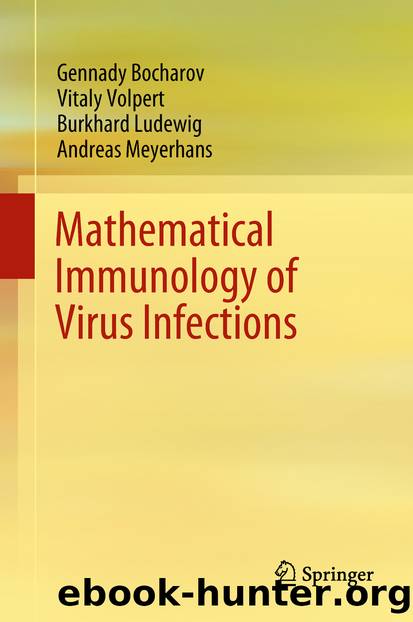Mathematical Immunology of Virus Infections by Gennady Bocharov Vitaly Volpert Burkhard Ludewig & Andreas Meyerhans

Author:Gennady Bocharov, Vitaly Volpert, Burkhard Ludewig & Andreas Meyerhans
Language: eng
Format: epub
Publisher: Springer International Publishing, Cham
(4.16)
that is the severity of the hepatitis increases as a squared root of the infection dose.
The mathematical model can be further used to examine the infection outcome/severity of the liver disease after peripheral LCMV-WE infection with pfu via liver, i.e. intrahepatic infection. The liver infection of naive C57BL/6 mice would result in severe hepatitis for doses ranging in between 10 and pfu, see Fig. 4.17 Right, (a). One might try to prevent this unfavourable outcome by adoptively transferring LCMV-specific effector or precursor CTLs. The impact of effector CTL is presented in Fig. 4.17 Right, (b). First, there exists a threshold number of effector CTL cells conferring an immediate type of protection against virus spread and severe disease. With the CTL number above the threshold, the LCMV population is eliminated in less than 1 day, with no signs of the disease. If the number of transferred lytic CTL is below threshold then protection against the liver disease is not conferred, although the virus is likely to be eliminated.
Fig. 4.17Analysis of the impact of viral and immune status parameters on the essential characteristics of LCMV-WE infection associated liver disease. Left: Intravenous infection with pfu is considered. Left: I.v. infection. a severity of the disease in terms of peak AST level as a function of initial virus dose; b effect of the initial number of virus-specific cytolytic effector T cells injected into blood at day 0 of infection on the serum AST level and the time until virus is eliminated below detection level of 100 pfu/ml; c effect of the initial number of precursor T cells present in spleen at day 0 of infection on the serum AST level and the time until virus is eliminated below detection level of 100 pfu/ml. Right: Peripheral infection. a severity of the disease in terms of peak AST level as a function of initial virus dose; b effect of the initial number of virus-specific cytolytic effector T cells injected into blood at day 0 of infection on the serum AST level and the time until virus is eliminated below detection level of 100 pfu/ml; c effect of the initial number of precursor T cells present in spleen at day 0 of infection on the serum AST level and the time until virus is eliminated below detection level of 100 pfu/ml.
Reprinted from Journal of Theoretical Biology, Vol. 221, Bocharov et al., Modelling the Dynamics of LCMV Infection in Mice: II. Compartmental Structure and Immunopathology, Pages 349–378, Copyright 2003, with permission from Elsevier
Download
This site does not store any files on its server. We only index and link to content provided by other sites. Please contact the content providers to delete copyright contents if any and email us, we'll remove relevant links or contents immediately.
| Automotive | Engineering |
| Transportation |
Whiskies Galore by Ian Buxton(41534)
Introduction to Aircraft Design (Cambridge Aerospace Series) by John P. Fielding(32892)
Small Unmanned Fixed-wing Aircraft Design by Andrew J. Keane Andras Sobester James P. Scanlan & András Sóbester & James P. Scanlan(32576)
Craft Beer for the Homebrewer by Michael Agnew(17936)
Turbulence by E. J. Noyes(7704)
The Complete Stick Figure Physics Tutorials by Allen Sarah(7144)
Kaplan MCAT General Chemistry Review by Kaplan(6601)
The Thirst by Nesbo Jo(6442)
Bad Blood by John Carreyrou(6281)
Modelling of Convective Heat and Mass Transfer in Rotating Flows by Igor V. Shevchuk(6227)
Learning SQL by Alan Beaulieu(6039)
Weapons of Math Destruction by Cathy O'Neil(5837)
Man-made Catastrophes and Risk Information Concealment by Dmitry Chernov & Didier Sornette(5655)
Digital Minimalism by Cal Newport;(5394)
Life 3.0: Being Human in the Age of Artificial Intelligence by Tegmark Max(5193)
iGen by Jean M. Twenge(5164)
Secrets of Antigravity Propulsion: Tesla, UFOs, and Classified Aerospace Technology by Ph.D. Paul A. Laviolette(4999)
Design of Trajectory Optimization Approach for Space Maneuver Vehicle Skip Entry Problems by Runqi Chai & Al Savvaris & Antonios Tsourdos & Senchun Chai(4845)
Electronic Devices & Circuits by Jacob Millman & Christos C. Halkias(4751)
